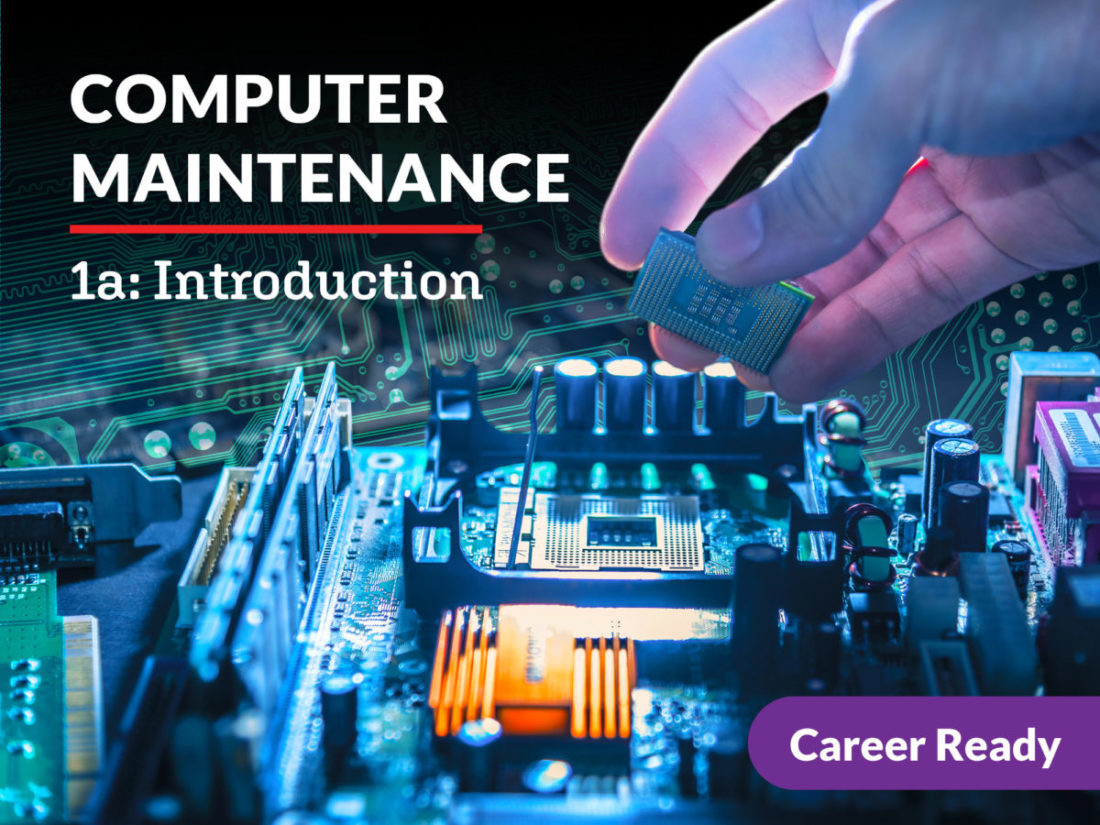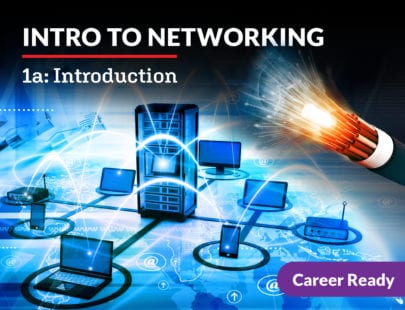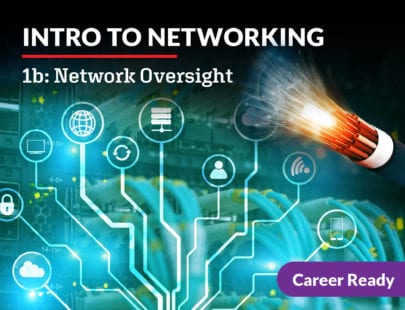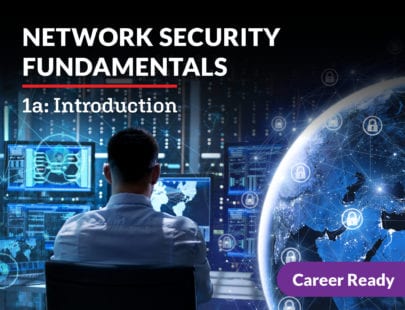
Computer Maintenance 1a: Introduction
Computers are soldered into all aspects of our daily life, and when they stop working, it can seem like our network has collapsed. If you are fascinated by the inner workings of computers and how to keep them running, then a career in computer maintenance may be for you! In this course, you’ll learn how computers are set up starting with the software and operating systems and what to do when hardware and software issues are encountered. You’ll learn different types of data communication, various power supply units, essential components like motherboards and memory and much more! Grab your personal expansion card, and let’s hardwire some new knowledge about computer maintenance.
Units at a Glance
Unit 1: Software Applications
You can’t do a whole lot with your computer if you don’t have software applications! Think of all the different processes for which you might use a computer: creating documents, video conferencing, preparing presentations, creating a script for a computer game, the list goes on and on. As a network technician in training, you will interact with the software applications used at your place of work. You will need to understand the licensing, installation, management, and troubleshooting of application software. Let’s get started!
What will you learn in this unit?
- Identify the different types of software applications
- Compare closed source and open source software, and describe different types of licensing for software use
- Contrast local and network software installation, and explain the difference between an update, patch, service pack, and upgrade
- Discuss the various Windows Control Panel applets
- Summarize the steps in the IT troubleshooting process
- Troubleshoot application software issues
Unit 2: Operating Systems
Before we get to all the various hardware you can install on a computer, we need to talk operating systems! Your OS controls a computer’s hardware and is where all the software applications run. As a network technician, you might deal with operating systems on a variety of devices, such as desktop computers, servers, tablets, and smartphones. In addition to knowing how an OS is installed or upgraded on all the computer types you may come into contact with, you also need to know the features and tools for different operating systems, and how to troubleshoot OS problems.
What will you learn in this unit?
- Describe operating system requirements, including device types and processor options
- Explain the elements of OS installation, including boot methods and installation types
- Discuss basic Windows OS security settings
- Utilize various Windows OS features and tools
- Compare and contrast the features and tools of the Mac and Linux operating systems
- Troubleshoot various Window OS issues
Unit 3: Printers
Who even uses a printer anymore? While most documents can be sent back and forth electronically, sometimes a hard copy of a document is required for official transactions. A network technician needs to have an active knowledge about the various types of printers because you never know what type of printer you might be asked to install or troubleshoot while on the job.
What will you learn in this unit?
- Differentiate between printers, virtual printers, scanners, and readers
- Describe laser and inkjet printer functionality, parts, and maintenance
- Compare and contrast impact, thermal, and 3D printers and their associated parts and maintenance
- Install wired and wireless printers
- Troubleshoot common printer issues
Unit 4: Operational Procedures for Optimal Network Performance
In many ways, a network technician is like a gatekeeper—responsible for protecting the hardware, software, and data that an organization relies on to get things done. This is no small task. Luckily, there are lots of tools to help technicians be the eyes and ears of the network and keep it safe and functional. From automation strategies to documented guidelines and safety procedures, you don’t have to reinvent the wheel—you just have to keep it spinning!
What will you learn in this unit?
- Explain how data is communicated and translated into binary, denary, and hexadecimal numbering systems
- Automate various tasks using scripts
- Follow safety procedures and dispose of electronics in an environmentally friendly manner
- Use hardware legally and ethically
- Adhere to legal and ethical guidelines when using software
Unit 5: Power and Peripherals
Let there be light! One of the foolproof ways we can know if a device is functioning is if we see the “power” light on. In networking environments, perhaps the most important component of a computer is the power supply; without it the computer just does not work! In this unit, we will learn what a power supply is and what it does. Then, we’ll learn about various types of displays and peripheral devices that can be added to create a customized computer system. Finally, we’ll talk about how to troubleshoot power supplies, video displays, and peripherals.
What will you learn in this unit?
- Understand how electricity flows through electrical devices
- Summarize power supply types and features
- Explain how input and output devices work
- Discuss the function of specialized peripheral devices
- Troubleshoot power, battery, peripheral, and display issues
Unit 6: Cables, Connectors, and Tools
Can we even imagine a world without the internet? Or video streaming? Probably not. But believe it or not, the way that media has been delivered to us has changed quite a bit over time. Let’s learn about the cables, connectors, and tools that bring us the entertainment and information we need for work and school and how to fix some major problems we may run into when using the internet or setting up computers.
What will you learn in this unit?
- Compare and contrast internet connection types and their features
- Explain cable types and their uses
- Identify various types of connectors
- Troubleshoot problems with cables, connectors, and internet connections and identify applicable troubleshooting tools
Unit 7: Motherboards, CPUs, and RAM
They say a triangle is the strongest geometric shape because, unlike other polygons, it cannot be transformed into other shapes by applying pressure. Its lines can’t move or slant—it just is what it is, and it is not going anywhere! The motherboard, central processing unit, and random access memory are like the three sides of your computer triangle. They are the most important components of a computer system because they decide how fast the system can process the data. Let’s take a look at how these parts operate and what to do when you run into issues with them.
What will you learn in this unit?
- Compare and contrast various motherboards types and features
- Understand how BIOS and UEFI help the boot up process
- Identify the components and functions of a CPU
- Discuss how RAM processes data and eliminates errors
- Troubleshoot issues with motherboards, CPUs, RAM, and other computer parts
Unit 8: Storage Devices and Custom Builds
The ability to store data files, videos, and pictures is a vital function of a computer for most users. But those files all need somewhere to live. That’s where storage devices come in. Think of a storage device like a file cabinet—only you have a lot more “folders” on it than you can fit into any physical file cabinet. Depending on the type of custom computer setup you’re building, your storage needs will vary. Whether you’re into graphic design, audio or video editing, or gaming—or dream of maintaining a large commercial network—let’s build the computer of your dreams!
What will you learn in this unit?
- Describe the purpose of internal hard drives
- Discuss several varieties of portable storage options
- Explain how RAID provides protection against drive failures
- Design a custom computer for different needs
- Problem-solve issues with storage devices using troubleshooting steps
Required Materials
Physical
- Video recording device
- Pen and paper
Software
- Word processing software
- Barcode creator
- QR code creator
- Text or Caret (Chromebook)
- Presentation software
- Graphic design software



